Would a corn snake eat a hatchling? Description of the study
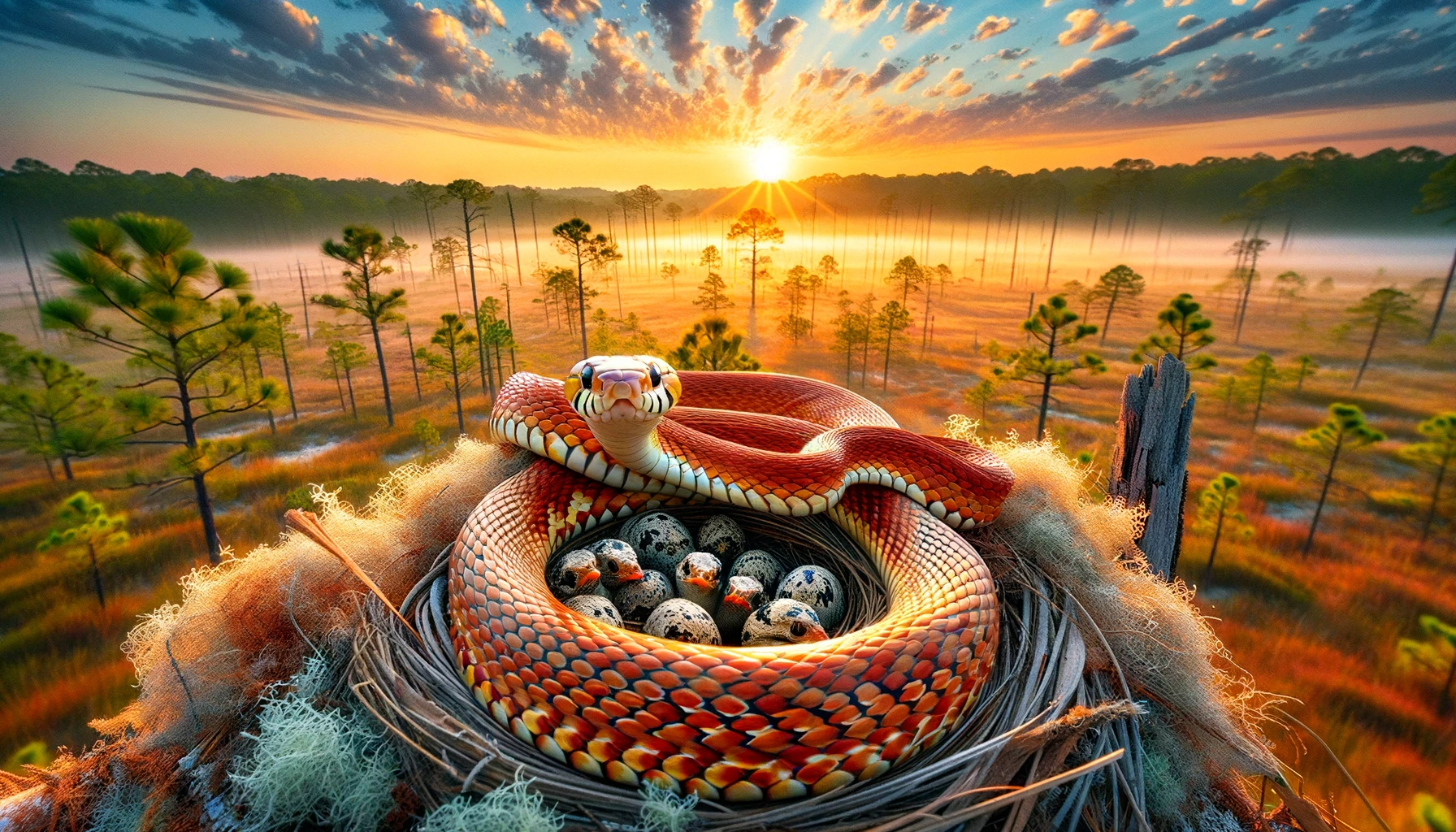
In home conditions food for a corn snake mainly consists of frozen rats and mice. Numerous studies also confirm that rodents are the primary food for corn snakes (Pantherophis guttatus) in nature. Primary - but not the only one. Researchers from the University of Illinois at Urbana-Champaign in 2016 presented an interesting study on the feeding preferences of corn snakes in the context of hunting for bird chicks.
Corn Snake - Not Just a Domestic Snake
Corn snakes are among the most commonly kept domestic snakes in Europe. Pantherophis guttatus are known for their distinctive, rich coloration and are valued as terrarium animals for gentle temperament of the species. Also significant for their popularity is a wide spectrum of interesting behaviors in corn snakes, which did not go unnoticed by scientists conducting research in the Savannah River Site area in South Carolina.

According to information cited by researchers, Pantherophis guttatus is a medium-sized snake, growing up to 180 cm in total length. The corn snake is classified as a constrictor reptile and is found in many types of habitats in the southeastern USA. In natural conditions, wild corn snakes can be mostly found from April to June, mainly during twilight and night.
Although many aspects of their life and diet remain a mystery, thanks to the discussed studies we gain interesting information about corn snakes as predators of bird nests. Among other things, the following were examined:
- The frequency with which raiding bird nests ends in success,
- The length of corn snake visits to nests,
- The frequency of visits to nests.
Interesting interactions between corn snakes and other snake species were also observed, including another popular species of domestic snake, such as the rat snake.

Do Corn Snakes Eat Birds? Study Methodology
The main area of study was about 200 ha of diverse terrain, including wetlands, forests, and open spaces. Cameras placed at bird nests located below 3 meters above the ground were used for observations - allowing for the filming of events within the nests. In this way, 97 cases of snake predation on feathered individuals of various species were analyzed. In 25% of cases, at least one corn snake was involved.
The studies were conducted over three bird breeding seasons (2011-2013). After each act of predation, researchers analyzed video recordings, identifying animals and documenting their behaviors and the time of the event, taking into account weather data (including temperature) and its impact on the predatory behaviors of snakes.
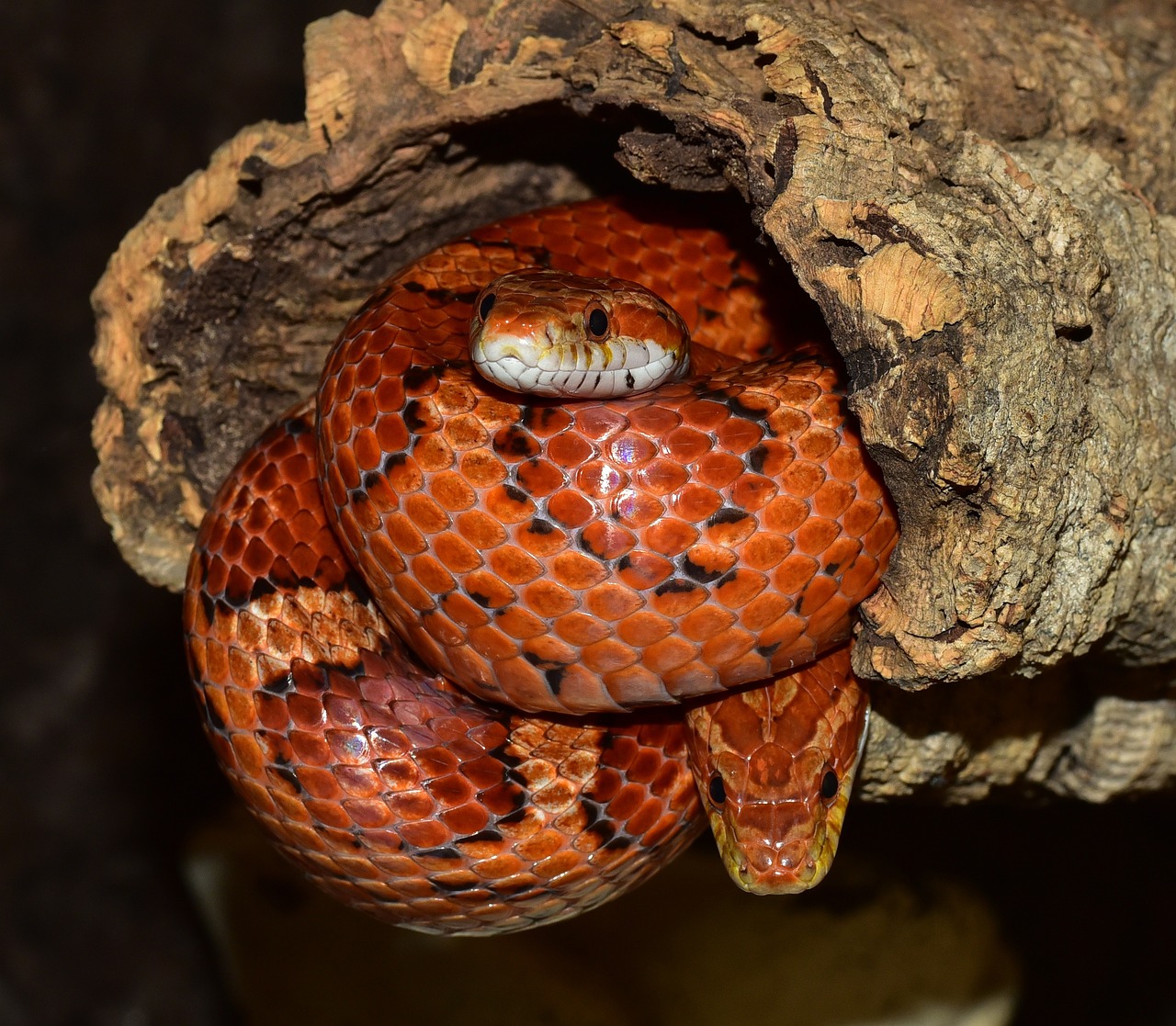
Corn Snake versus Rat Snake and Coluber constrictor— A Comparison
To better understand the behavior of corn snakes, a comparison was made with other sympatric snakes in the region, including rat snakes (Pantherophis alleghaniensis and P. obsoletus) and Coluber constrictor. The rat snake turned out to be the most frequent predator of bird nests, accounting for 28% of all chick breeding failures. The corn snake was second, accounting for 15% of cases, and the snake Coluber constrictor third (12%). The whipsnake Masticophis flagellum, although also present, accounted for just under 4% of nest failures. In total, 137 cases of snake predation in nests were identified, with 10 cases observed where more than one snake species hunted the same nest.
Where and When Do Corn Snakes Search for Food in Bird Nests?
While many species of snakes (including the rat snake and Coluber constrictor) prefer hunting feathered prey in the comfortable conditions offered by forest edges, corn snakes showed no such preferences. In the case of corn snakes, no relationship was also shown between the distance between nests and structures offering shelter for reptiles.
However, the search for nests by corn snakes intensified during the breeding season. In the case of this species, visits to nests were observed only in evening and nighttime conditions. For comparison - individuals of the species Coluber constrictor searched for food in bird nests only during the day.
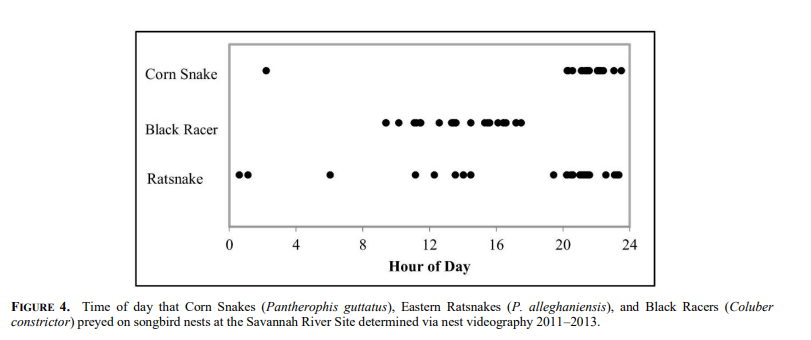
How Do Corn Snakes Hunt for Birds?

Corn snakes in home breeding are considered absolute loners, requiring small-sized terrariums (i.e., terrarium length of the snake) exclusively. Cohabitation of corn snakes with any species of reptiles at any point in life outside of the breeding period is not recommended for practical reasons related to maintaining breeding. This means that we do not know too much about their relationships with other animals. Therefore, discoveries concerning the behavior of corn snakes, including the ability to use cues from other snakes to locate prey and their preference for hunting chicks, were particularly interesting.
Several cases of interaction between two snakes at the same nest were documented: in one case, a corn snake tried to access the nest while a rat snake was swallowing chicks. In other cases, corn snakes were observed arriving at nests after other snakes had already plundered them. Such behavior suggests that corn snakes may actively follow other snakes to eat food left by other individuals or hunt for chicks that have attempted to escape by jumping from the nest.
While the snake Coluber constrictor often (in 36% of cases) took prey away from nests, presumably to reduce the risk of encountering obstacles such as adult birds or predators, the rat snake almost always consumed its prey at the nest (96% of cases). Similarly, corn snakes (93%), although they occasionally fell from the nest while manipulating the chicks, then finished feeding on the ground.
Cases known from other studies, where a rat snake or king snake (Lampropeltis getula) covered the top of nests and held the chicks with their bodies, were observed here only five times (6%), including only once (6%) by a corn snake. However, there was a case where a rat snake tightly wrapped its body around the nest, preventing a corn snake from accessing an uneaten mockingbird chick.
Which Birds Do Corn Snakes Prey On?
Cameras documenting cases of reptile foraging on feathered prey were placed at 206 nests of 13 bird species, 6 of which were mentioned in the study as potential food for corn snakes:
- Northern Cardinal (Cardinalis cardinalis) [weight: 33-65g; egg size: up to 27 mm x 20 mm; egg weight: 5 g; chick weight: from 3-4 g to 25 g when leaving the nest]
- Blue Grosbeak (Passerina caerulea) [weight: 26-31g; egg size: 24 mm x 17 mm]
- Brown Thrasher (Toxostoma rufum) [weight: 61-89g; egg size: up to 27 mm x 19 mm; egg weight: 6 g; chick weight: from 5-7 g to 48 g when leaving the nest]
- Indigo Bunting (Passerina cyanea) [weight: 12-18g; egg size: up to 21 mm x 15 mm; egg weight: 2 g; chick weight: from 2 g to 12 g when leaving the nest]
- Painted Bunting (Passerina ciris) [weight: 13-19g; egg size: up to 19 mm x 21 mm; chick weight: from 2 g to 12 g on the day of leaving the nest]
- White-eyed Vireo (Vireo griseus) [weight: 7-14 g; egg size: up to 21 mm x 15 mm; egg weight: 2 g; chick weight: from 2 g to 11 g when leaving the nest]
To enhance the usefulness of the list in the context of feeding corn snakes in captivity, I have included data on the weight of adult individuals, chicks, and eggs alongside each species name. The source of data was the Cornell Lab of Ornithology.

Chicks, Eggs, or Adult Birds? What Does the Corn Snake Eat in Nature?
An interesting discovery was that corn snakes never attacked adult birds in the nest, even when they were sleeping. Although they approached them up to 11 times, in most cases they simply tried to push the adult birds out of the nest or squeeze under them to access the nest's contents. Unlike rat snakes and Coluber constrictor, which sometimes attacked adult birds, corn snakes seemed to focus exclusively on chicks, ignoring adult birds even in situations where they seemed large enough to eat.
These observations suggest that corn snakes may avoid confrontations with adult birds to prevent scaring them and causing the premature departure of the chicks from the nest. This strategy may be more efficient as focusing on chicks provides greater and easier energetic gain. The commotion associated with attacking adult birds could complicate the hunt and cause potential prey to escape.
The study also showed that corn snakes were almost five times more likely to hunt for chicks than eggs. There was an instance where a corn snake left a nest without eating an egg present in it, despite no alternative food being available.
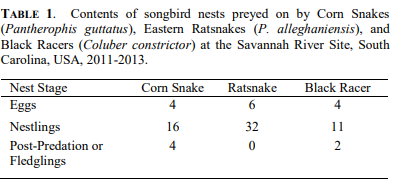
What This Means for Us: Chicks and Eggs as Food for Corn Snakes
The above data provide us with valuable information for feeding corn snakes in captivity. The data on birds that fell prey to animals in nature can be transferred to knowledge on how to diversify the diet of domestic snakes. Among the whole prey and feed available in Poland, we can find several options that match the parameters listed in the study:
- Frozen one-day-old quail chicks,
- Frozen quails 20/30 g,
- Frozen one-day-old chickens.
It's obvious that when feeding, the size of the meal should primarily be adjusted to the age and size of the corn snake. The size of the offered food will significantly differ depending on whether we are taking care of a young snake in its first year of life or a resident of the terrarium that is already several years old. It is assumed that the weight of the meal should be about 10% of the snake's body weight. The size of the prey can be larger than the head of the snake, but should not exceed 1.5 times the volume of the snake at its thickest part.
Taking advantage of the possibilities offered by the discussed study, I analyzed potential food for corn snakes from another aspect, namely in relation to the weight of the birds that the animals chose for their meals in nature.
One-day-old quail chicks as feed for corn snakes
Considering the data from the discussed study, one-day-old quail chicks definitely win the ranking for the optimal feed for corn snakes.
Firstly, every corn snake that kindly agreed to participate in the study chose chicks for food, never adult birds.
Secondly, the weight of one-day-old quails (5-7 g) corresponds to the weight of the chicks of each of the bird species mentioned by the researchers:
- Scarlet Cardinal (Cardinalis cardinalis) - from 3-4 g to 25 g,
- Brown Thrasher (Toxostoma rufum) - from 5-7 g to 48 g,
- Indigo Bunting (Passerina cyanea) - from 2 g to 9 g,
- Painted Bunting (Passerina ciris) - from 2 g to 12 g,
- White-eyed Vireo (Vireo griseus) - from 2 g to 11 g.
The data on the weight of the Blue Grosbeak (Passerina caerulea) chicks are not known, but the size of the eggs and the weight of the adult individuals allow us to assume that here too, frozen quail chicks will be a suitable substitute. Thus, frozen one-day-old quails gain the highest rank 6/6 in the category food for corn snakes, but a single quail will not satisfy the hunger of a snake heavier than 70 g.
Quail 20/30g as food for corn snakes
Frozen quails weighing 20/30g are still young individuals, which could also potentially interest a corn snake looking for food, considering the fact that snakes hunt for grown-up chicks that escape from the nest. Weight-wise, these quails correspond to the chicks of the Scarlet Cardinal (from 3-4 g to 25 g) and the Brown Thrasher (5-7 g to 48 g).
Although these are only two of the six bird species observed in the diet of wild snakes, frozen quails 20/30 g have a significant advantage over chicks: they can satisfy the hunger of a corn snake weighing from 200 to 300 g.
One-day-old chickens 35-40g for corn snakes
If our terrarium is home to a corn snake that is several years old, feeding it quail chicks is probably not as effective as choosing one-day-old chickens. Their weight matches only the weight of one of the chick species discussed in the study (Brown Thrasher, up to 48 g), but one-day-old chickens are the most sensible choice for corn snakes weighing over half a kilogram.

Quail Egg as Food for Corn Snakes
Some of the corn snakes observed during the study chose to consume unhatched eggs found in the nest, which could justify the presence of eggs in the diet of terrarium animals. The problem is that according to the study, corn snakes foraged in nests of birds whose eggs were smaller and lighter than quail eggs. Their average size is 35 mm x 27 mm, and weight 9 g. None of the bird species observed by the researchers lay eggs as large and heavy as those of quails, but it's important to remember that the range of corn snakes extends far beyond the Savannah River Site area. It's likely that in other regions, corn snakes encounter and eat eggs similar in size and weight to those of quails.
Feeding Corn Snakes Chicks in Practice
I wouldn't be myself if I didn't check the acquired data in practice, having the opportunity to do so. While working on this article, I ordered frozen one-day-old quail chicks from the Raw PetFood store to see if my corn snake would be tempted by such a meal.
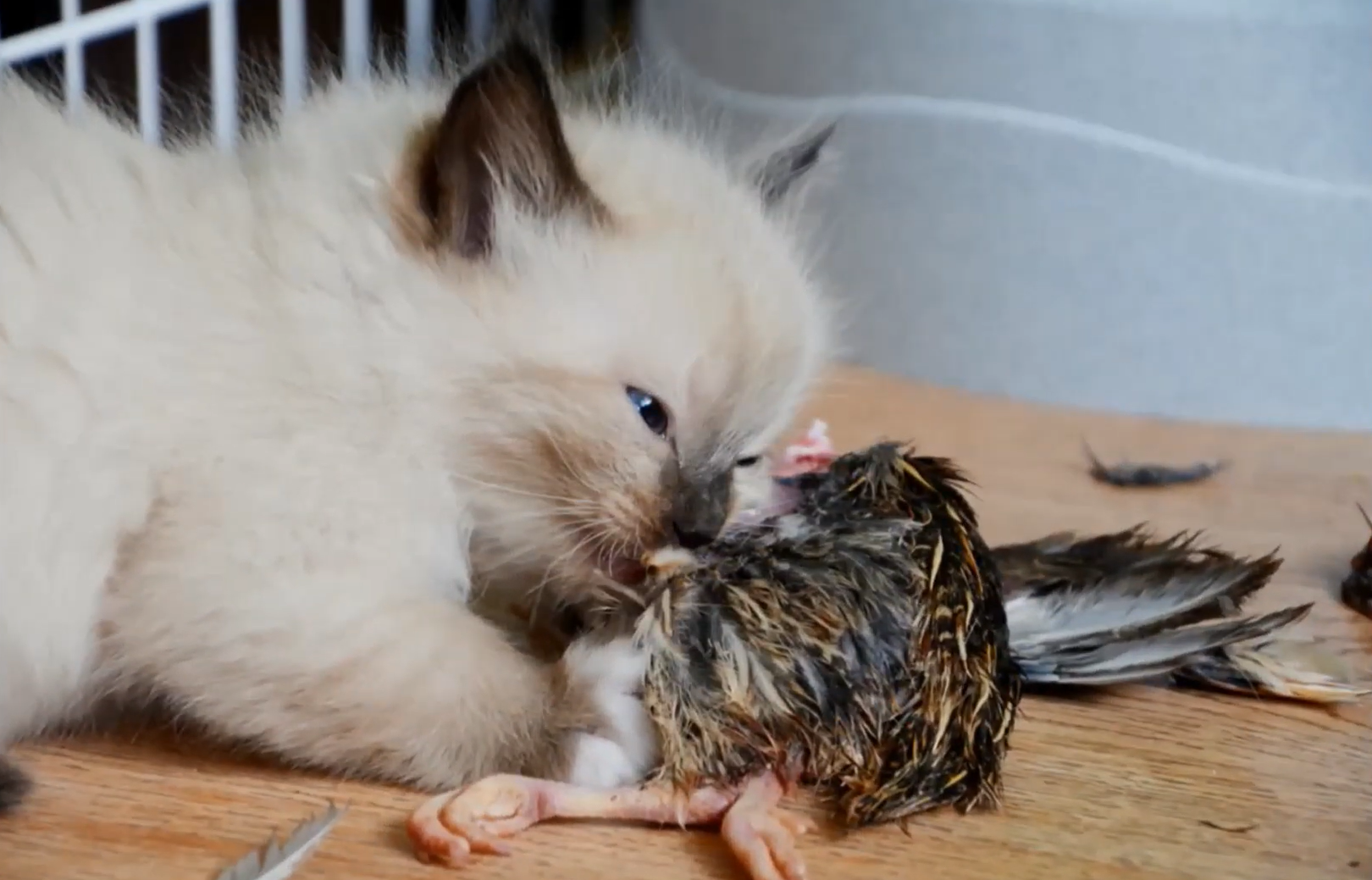
I have the luxury that in my home not only lives a corn snake that eats frozen food, but also four Ragdolls, including two that prefer a whole prey diet for cats. This means that whatever the snake doesn't eat simply becomes food for the cats. Nothing goes to waste.
My snake cannot yet boast impressive length or weight — it hatched last year. For this reason, I thawed a few quails that seemed the smallest to me, and after thawing and straightening them, I selected them again. The smallest quail was given to the snake, the rest became food for the cats. To adjust the chick to the weight of the snake and facilitate the eating of the new food, I removed the beak, legs, and wings before feeding.
I did not spend time analyzing the appearance of bird nests. I limited myself to the information that most of the birds mentioned in the study nest low (sometimes on the ground), focusing on the abundant vegetation above the nest. I placed the thawed chick at room temperature in a bowl styled like a leaf and placed it in a plant-shaded spot in the terrarium. What's intersting, although I placed the food in the terrarium in the late afternoon and the snake located the prey then, he did not eat it immediately. It went about its business and only returned to eat it at night.
Under cover of night, the corn snake, which had until now been fed only mice, turned out to be very excited about the new food. The length of the prey proved somewhat troublesome for him, yet he devoured it with gusto, using his body to "suffocate" and hold the bird. After dinner, he hid in its favorite, warm hideout. He looked satisfied, so I am satisfied too — one-day-old quail chicks will likely diversify my snake's diet more than once in the future.
The article was prepared based on the study: Ecology and predatory behavior of corn snakes (Pantherophis guttatus) in bird nests, authored by: Brett A. Degregorio, Patrick J. Weatherhead, Jinelle H. Sperry. Data on the weight of individual bird species comes from the Cornell Lab of Ornithology database.
Article text: inessiwinska@gmail.com
Recommended

Day-old chicks (chickens) 10kg

Day-old chicks (chickens) 1kg





